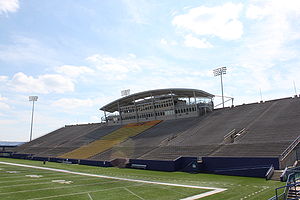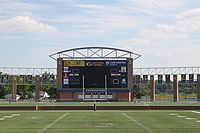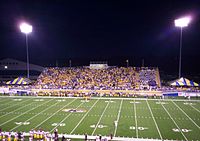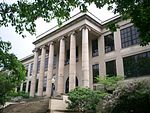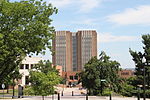- Dix Stadium
-
Dix Stadium Former names Memorial Stadium (1969–71) [1] Location 2227 Summit Road
 Kent, Ohio, United States
Kent, Ohio, United StatesCoordinates 41°8′21″N 81°18′48″W / 41.13917°N 81.31333°WCoordinates: 41°8′21″N 81°18′48″W / 41.13917°N 81.31333°W Broke ground 1968 Opened September 13, 1969 [1] Renovated 2008 Owner Kent State University Operator Kent State University Surface FieldTurf (2005–present)
Astroturf (1997–2004)
Natural grass (1969–96)Scoreboard 72 ft (22 m) wide, 30 ft (9.1 m) tall[2] Construction cost $3.5 million USD [1]
($21 million in 2011 dollars[3])Architect Osborn-Papesh General Contractor Melborne Brothers Capacity 20,500 (since 2008) [1]
29,287 (2003–07)
30,520 (1969–2002)Record attendance 27,363 Tenants Kent State Golden Flashes football (NCAA) (1969-present)
Kent State Golden Flashes field hockey (NCAA) (1997–2005)Dix Stadium is a stadium in Kent, Ohio, United States. It is primarily used for American football, and is the home field of the Kent State Golden Flashes football team. It lies at the far eastern end of the KSU campus along Summit Street, just east of State Route 261 and is the center piece of what has become an athletic complex. From 1997-2005, the field hockey team also played its games at the stadium until a new field hockey stadium was constructed behind Dix Stadium. The KSU Softball, Women's Soccer, Field Hockey, and Indoor Track teams all play their home matches in facilities around Dix Stadium. The stadium also hosts the occasional high school football game and served as the host of the 2001 NCAA Division I Field Hockey Championship. It opened on September 13, 1969 with a win against in-state rival Dayton. It was named in honor of Robert C. Dix, a member of Kent State's Board of Trustees for more than three decades.[1]
The 25,000-seat stadium consists of three separate grandstands on each side of the field except the south side. The west side is the largest, and the recently rebuilt east side (student seating) is the smallest. On either side of the east grandstands are spaces for party tents. Although the first night game was held in 1990, permanent lights were not added until 1996. Artificial turf was installed in 1997 and replaced in 2005 with the latest version of FieldTurf. Prior to the 2002 season, the east side stands, remnants of the original Memorial Stadium, were demolished. The current east side bleachers were constructed after the 2002 season and were completed in time for the 2003 season opener. The configuration slightly altered the stadium's seating capacity reducing it from 30,520 to 29,287 before the latest renovations reduced capacity to the current figure of 20,500.
Contents
Upgrades
In June 2007, the university began phase one of a two year project of renovations and upgrades to Dix Stadium. Phase one included repainting the north end zone bleachers as well as upgrades to the press box and a permanent canopy over the camera areas. Entryways to the west stands were upgraded with improved signage and cosmetic improvements were done around the main concourse. A new road to the neighboring field house was also constructed.
Phase two of the renovations began in February 2008 with the demolition of the sound end zone seats and scoreboard[4] and removal of the perimeter fencing around the stadium. Improvements included replacing the fencing with a brick and wrought iron fence as well as the construction of new entrances and ticket booths at the west entry.[5] In the south end zone, a new concession area and scoreboard were constructed. Phase one was mostly completed by the beginning of the 2007 home football season in September[6][7] and phase two was completed in time for the Flashes' first home game on 13 September 2008 against the Delaware State University Hornets.
Trivia
- The current north end zone section of Dix Stadium dates to 1948 and was one of the sideline seats at KSU's old Memorial Stadium (the south end zone, demolished in 2008, was the other sideline), which stood on what is now the visitor parking lot in front of the Memorial Athletic and Convocation Center and Student Center.[1] When Dix Stadium was built in the late 1960s, the old stadium was dismantled and then reassembled at the current site in its current configuration.
- Although many crowds have come close, Dix Stadium has never officially been sold out for a Kent State game. The largest KSU football crowd ever at Dix Stadium was 27,363 on November 10, 1973 for a game versus Miami University.[2] The stadium was, however, sold out in August 1980 for a scrimmage between the Cleveland Browns and the Buffalo Bills and nearly sold out for a November 28, 1998 high school playoff game between Cleveland St. Ignatius and Canton McKinley.
References
- ^ a b c d e f "Dix Stadium". KentStateSports.com. Kent State University. 2008-09-02. http://www.kentstatesports.com/ViewArticle.dbml?&DB_OEM_ID=11400&ATCLID=1573507. Retrieved 2008-09-10.[dead link]
- ^ a b "Dix Stadium" (PDF). 2009 Kent State Football Media Guide. Kent State University. 14 August 2009. pp. 134, 135. http://www.kentstatesports.com//pdf5/629105.pdf?DB_OEM_ID=11400. Retrieved 16 September 2009.[dead link]
- ^ Consumer Price Index (estimate) 1800–2008. Federal Reserve Bank of Minneapolis. Retrieved December 7, 2010.
- ^ Krell, Steph (2008-02-01). "KSU's Dix Stadium getting makeover". Record-Courier (Kent and Ravenna, Ohio).
- ^ David, Carducci (2008-02-06). "The birth of a 'new' of Dix Stadium". Record-Courier (Kent and Ravenna, Ohio). http://www.recordpub.com/news/article/3258271. Retrieved 2008-02-11.
- ^ Offseason will feature upgrade of Dix Stadium http://www.recordpub.com/news/article/1131721
- ^ Dix Stadium renovation set to commence http://www.recordpub.com/news/article/2001132
External Links
Football stadiums of the Mid-American Conference East Division InfoCision Stadium – Summa Field (Akron) • Doyt Perry Stadium (Bowling Green) • University at Buffalo Stadium (Buffalo) • Dix Stadium (Kent State) • Yager Stadium (Miami) • Peden Stadium (Ohio) • Lincoln Financial Field (Temple)
West Division Scheumann Stadium (Ball State) • Kelly/Shorts Stadium (Central Michigan) • Rynearson Stadium (Eastern Michigan) • Brigham Field at Huskie Stadium (Northern Illinois) • Glass Bowl (Toledo) • Waldo Stadium (Western Michigan)
Championship College football venues in Ohio Division I
FBSBig East Big Ten Ohio Stadium (Ohio State)
MAC Dix Stadium (Kent State) • Doyt Perry Stadium (Bowling Green) • Glass Bowl (Toledo) • InfoCision Stadium – Summa Field (Akron) • Peden Stadium (Ohio) • Yager Stadium (Miami)
Division I
FCSMissouri Valley Pioneer Division II GLFC McPherson Stadium (Central State) • Urbana University Stadium (Urbana)
GLIAC Community Stadium (Ashland ) • Donnell Stadium (Findlay) • Frosty Kalnow Stadium (Tiffin) • Jack Britt Memorial Field (Lake Erie) • Panther Field (Ohio Dominican)
Division III Heartland Coressel Stadium (Defiance) • Salzman Stadium (Bluffton) • Schueler Field (Mount St. Joseph)
North Coast Deeds Field–Piper Stadium (Denison) • Dill Field (Oberlin) • Edwards–Maurer Field (Wittenberg) • Henry Field (Hiram ) • John P. Papp Stadium (Wooster) • McBride Field (Kenyon) • Selby Field (Ohio Wesleyan)
Ohio Bernlohr Stadium (Capital) • Dial–Roberson Stadium (Ohio Northern) • Don Drumm Stadium (Marietta) • Don Shula Stadium at Wasmer Field (John Carroll) • Frost-Kalnow Stadium (Heidelberg) • George Finnie Stadium (Baldwin–Wallace) • Memorial Stadium (Otterbein) • McConagha Stadium (Muskingum) • Mount Union Stadium (Mount Union) • Williams Stadium (Wilmington)
UAA Case Field (Case Western Reserve)
NAIA Mid-States Categories:- American football venues in Ohio
- Kent State Golden Flashes football venues
Wikimedia Foundation. 2010.

